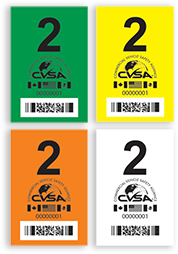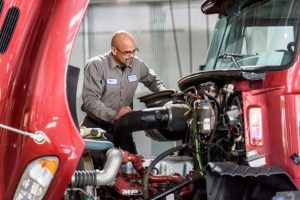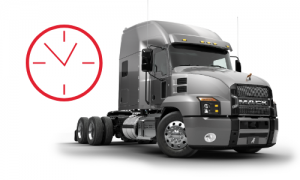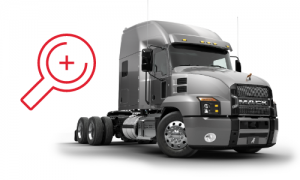
The Commercial Vehicle Safety Administration (CVSA) International Roadcheck will take place May 17-19, 2022. Over this 72-hour period, commercial motor vehicle inspectors throughout North America will conduct inspections on commercial motor vehicles and drivers. During the Roadcheck, inspectors will primarily conduct the North American Standard Level I Inspection Program, the uniform inspection steps, processes and standards established to ensure consistent compliance and enforcement. Its components regulate driver operating requirements and vehicle mechanical condition. Violations for any of the 37-points will mean the driver and/or vehicle will be forced out-of-service until the violations are corrected. Any vehicle that passes the inspection without any violations will receive a decal to ensure they can pass thru future inspections for a three-month period. For 2022, inspectors will focus on wheel ends which include wheels, rims, hubs and tires. All these components support heavy loads, maintain vehicle stability and control and are critical for braking and keeping over-the-road trucks and tractor-trailers operating safely on the road.

It is important to note that wheel ends have accounted for about a quarter of all vehicle out-of-service violations in recent years of the Roadcheck program. It as been identified as a top ten vehicle violation. Looking strictly at tire issues alone, in 2021 there were 156,687 violations, causing 88,347 trucks to be out of service.*
Bergey’s Truck Centers’ Parts Departments and Commercial Tire Centers offers many wheel end components, including wheel rims; locking rings, studs and clamps; wheel fasteners; wheel spokes; lubricant caps and plugs; valve stems, tires and retread services. In addition to routine pre- and post-trip inspections, there are some tell-tale ways drivers can pay attention to and report so that maintenance and or replacement can be handled in a timely manner. Look for abnormal or uneven tread wear, smoking or the smell of burning from a wheel end, extremely hot hubs, a vibration, wobble or noise while driving, changes in braking power and stopping distance, side-pulling while braking and even wheel lock-up and skidding.
Review the CVSA Wheel Ends Inspection process and the North American Level I Inspection procedure with your drivers so both you and they will be prepared with what to expect during the truck inspection and driver interview process. Being educated and prepared is a key component for ensuring compliance with all DOT regulations.
That’s quite a list! Plan ahead to make sure that your commercial trucks and wheel ends are in compliance. Bergey’s is making it easy to get your rig ready for the 2022 CVSA International Roadcheck by taking advantage of our DOT Inspection Special at our Service Departments. Our factory trained technicians will inspect the following:


While Driver Hours of Service may not be the primary area of focus for 2022, it is always reviewed during the inspection process. These strict regulations are in place to help reduce the occurrence of driver fatigue, and regulate on-duty time for drivers, including drive time and rest periods. In general, all carriers and drivers operating commercial motor vehicles must comply with HOS regulations found in 49 CFR 395.3.
The chart below summarizes the hours of service regulations from the Federal Motor Carrier Safety Administration for property-carrying drivers. Click the tabs to view the regulations.
May drive a maximum of 11 hours after 10 consecutive hours off duty.
May not drive beyond the 14th consecutive hour after coming on duty, following 10 consecutive hours off duty. Off-duty time does not extend the 14-hour period.
Drivers must take a 30-minute break when they have driven for a period of 8 cumulative hours without at least a 30-minute interruption. The break may be satisfied by any non-driving period of 30 consecutive minutes (i.e., on-duty not driving, off-duty, sleeper berth, or any combination of these taken consecutively).
May not drive after 60/70 hours on duty in 7/8 consecutive days. A driver may restart a 7/8 consecutive day period after taking 34 or more consecutive hours off duty.
Drivers may split their required 10-hour off-duty period, as long as one off-duty period (whether in or out of the sleeper berth) is at least 2 hours long and the other involves at least 7 consecutive hours spent in the sleeper berth. All sleeper berth pairings MUST add up to at least 10 hours. When used together, neither time period counts against the maximum 14- hour driving window.
Drivers are allowed to extend the 11-hour maximum driving limit and 14-hour driving window by up to 2 hours when adverse driving conditions are encountered.
A driver is exempt from the requirements of §395.8 and §395.11 if: the driver operates within a 150 air-mile radius of the normal work reporting location, and the driver does not exceed a maximum duty period of 14 hours. Drivers using the short-haul exception in §395.1(e)(1) must report and return to the normal work reporting location within 14 consecutive hours, and stay within a 150 air-mile radius of the work reporting location.

Now that you know what the inspector is looking for, let’s discuss one of the most effective ways to stay compliant and protect yourself from violations – pre- and post-trip inspections. Ensure your drivers are doing a thorough inspection of their commercial truck and all the major systems. This isn’t just “a good idea”. Inspecting the vehicle before driving each day is a Federal requirement and must be documented in the driver logbook/ELD as “on-duty, not driving” while completing this task. It should only take about 15 minutes.
By reviewing the inspection processes, educating your drivers, performing a DOT inspection with a reputable service partner, and ensuring your drivers are completing and documenting their log books properly or ensuring their ELD is properly functioning, you are well on your way to passing this year’s CVSA Roadcheck.